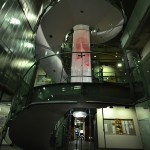
ECO
EcO
Our group was immediately attracted to the spiral staircase in the atrium spanning the fifth to seventh floors in the faculty of Engineering. The spiral staircase has a large presence in the atrium, which is mainly used by students to study, socialize, or simply wait (or sleep!) between classes. One side of the atrium is open to the Montreal skyline, while the other side helps to connect different parts of the building. Overall the space is quite pleasant, which is why people like to spend time there. However, there is also the sense that something is missing. Our group decided to do something with the wide hollow center of the spiral staircase, with the aim of bringing life to the space. We knew that we wanted to install some kind of physical structure, but we didn’t know what exactly.
-
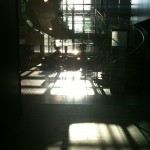
The 5th floor atrium on the engineering side of the building, filled with light.
-
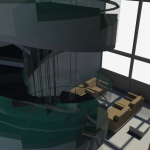
3D rendering of the spiral staircase, as viewed from the 7th floor.



Waterfall
Our first idea was to create a kind of waterfall by hanging light chains that would make water-like sounds when moved. But we quickly realized that chains would be too heavy for the structure, and also much too expensive (given our small-budget, that we agreed should be $100). We also considered creating a hanging sculpture of plastic water bottles, with the intention of making a ecological statement, but we never arrived at a strong concept.
-
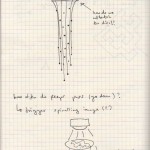
-
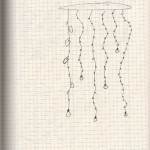
Hanging lights from above along with shiny parts on the stings to reflect light.
-

Our first idea was to promote healthy environmental issues. This illustrate water bottles hanged from above.




Chandelier
We eventually moved on to thinking about working with light. We liked the idea of hanging many LEDs in the stairwell, creating a kind of chandelier. Since we still wanted to be eco-friendly, we researched and found practical ways to use solar-powered lights. It was at this point that we also started to think about using helium balloons. We were looking for a way to suspend the lights, and we liked the idea that our installation could be entirely independent of both the existing structure and the building’s electricity supply. There was doubt about how well helium balloons would support the lights, and they also turned out to be very expensive, due to a global shortage of helium (and hence equally un-ecological). We also realized that cheap LED lights would fail to compete with the room’s existing after-dark lighting.
-

While hanging water bottles, we though to also hang either mirrors and/or reflective surface to reflect light that would be projected from under.
-
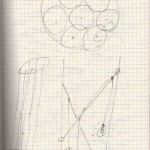
Should we hang the lights from helium inflated balloons or tie them to a complicated string mechanism?
-
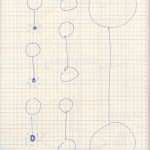
We’re still not sure as to what to hang from the balloons, light or another balloon?
-
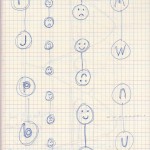
Sketching out the idea of equilibrium, is the glass half full or half empty?
-
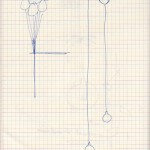
Hanging bulbs from helium balloons, and if the bulb is too heavy, add more helium balloon!
-

Hanging solar lights from helium filled balloons, the solar panel would rest on the floor, where there is most sun. The lights would be decorated with plastic bottles transformed to look like light fixture.




Static Energy
Experimenting with balloons in the stairwell, however, led us to make some interesting discoveries. We discovered that there is a strong static charge that attracts balloons towards the vertical steel rods – part of the supporting structure. This prompted us to think about using static electrical energy in our design. We were interested in the attraction, but we wanted the balloons to go towards the center of the stairwell, rather than stick to the structure. So we did some research on static electricity and found that statically charged PVC would repel the balloons in the same way that the steel rods attracted them. We tested this idea by hanging a large sheet of PVC – wrapped into the form of a cylinder – in the stairwell, and suspending balloons on the inside. This was unsuccessful for several reasons. Firstly, the static effect did not work as planned – we learned that there are many factors to consider and it became too complicated to understand fully. Secondly, the plastic looked dirty and generally unappealing. And lastly, the balloons were static, and although this was our intention, we felt that it was lacking in energy and vitality.
-
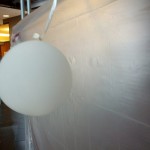
After charging the PVC sheet with static electricity, the balloons are effectively repulsed.
-

PVC cylinder with balloons in equilibrium.
-

The inside of the PVC cylinder.




Kinetic Energy
Our final iteration kept the idea of using a large cylinder, but this time using cloth – considerably more expensive (and pushing us over our budget), but much more attractive. We also kept the balloons, but this time they would be full of kinetic energy, being propelled around the inside of the cylinder by a fan at the bottom. We decided to use strong lights to light up this column of balloons from the inside, believing that this would create an exciting effect of fast-moving shadows and colors – all visible from the outside. This idea was successful, and we spent the remaining time constructing the column and finding effective ways to attach it to the supporting structure. In the end, the result was effective – the column of flying glowing colored balloons brought life to the space, inspiring wonder and excitement.
After looking at the final project using only red balloons, the cylinder shape and the shadow of the red balloons reminded us to the red blood cells of the human body, which after doing some research we found out that the red blood cells are the most common typed of blood cells in the body, also delivering oxygen to the body. So we thought that the idea of the red balloons representing red blood cells would perfectly fit our project at the end since what we wanted to do since the begining was to give life to the space and the building it self.
I think the main lesson we learned from this kind of project is that is it crucial to try things out on-site, which is what Christopher Alexander suggests. Nothing worked as expected and new ideas were born out of experimentation. The iterative process of trial and error was the only way we could have have succeeded.






